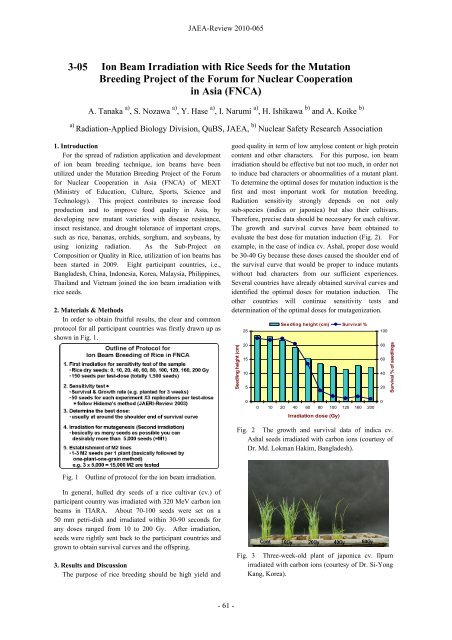JAEA-Review-2010-065.pdf:15.99MB - 日本原子力研究開発機構
JAEA-Review-2010-065.pdf:15.99MB - 日本原子力研究開発機構
JAEA-Review-2010-065.pdf:15.99MB - 日本原子力研究開発機構
Create successful ePaper yourself
Turn your PDF publications into a flip-book with our unique Google optimized e-Paper software.
3-05<br />
Ion Beam Irradiation with Rice Seeds for the Mutation<br />
Breeding Project of the Forum for Nuclear Cooperation<br />
in Asia (FNCA)<br />
A. Tanaka a) , S. Nozawa a) , Y. Hase a) , I. Narumi a) , H. Ishikawa b) and A. Koike b)<br />
a) Radiation-Applied Biology Division, QuBS, <strong>JAEA</strong>, b) Nuclear Safety Research Association<br />
1. Introduction<br />
For the spread of radiation application and development<br />
of ion beam breeding technique, ion beams have been<br />
utilized under the Mutation Breeding Project of the Forum<br />
for Nuclear Cooperation in Asia (FNCA) of MEXT<br />
(Ministry of Education, Culture, Sports, Science and<br />
Technology). This project contributes to increase food<br />
production and to improve food quality in Asia, by<br />
developing new mutant varieties with disease resistance,<br />
insect resistance, and drought tolerance of important crops,<br />
such as rice, bananas, orchids, sorghum, and soybeans, by<br />
using ionizing radiation. As the Sub-Project on<br />
Composition or Quality in Rice, utilization of ion beams has<br />
been started in 2009. Eight participant countries, i.e.,<br />
Bangladesh, China, Indonesia, Korea, Malaysia, Philippines,<br />
Thailand and Vietnam joined the ion beam irradiation with<br />
rice seeds.<br />
2. Materials & Methods<br />
In order to obtain fruitful results, the clear and common<br />
protocol for all participant countries was firstly drawn up as<br />
shown in Fig. 1.<br />
Fig. 1 Outline of protocol for the ion beam irradiation.<br />
In general, hulled dry seeds of a rice cultivar (cv.) of<br />
participant country was irradiated with 320 MeV carbon ion<br />
beams in TIARA. About 70-100 seeds were set on a<br />
50 mm petri-dish and irradiated within 30-90 seconds for<br />
any doses ranged from 10 to 200 Gy. After irradiation,<br />
seeds were rightly sent back to the participant countries and<br />
grown to obtain survival curves and the offspring.<br />
3. Results and Discussion<br />
The purpose of rice breeding should be high yield and<br />
<strong>JAEA</strong>-<strong>Review</strong> <strong>2010</strong>-065<br />
- 61 -<br />
good quality in term of low amylose content or high protein<br />
content and other characters. For this purpose, ion beam<br />
irradiation should be effective but not too much, in order not<br />
to induce bad characters or abnormalities of a mutant plant.<br />
To determine the optimal doses for mutation induction is the<br />
first and most important work for mutation breeding.<br />
Radiation sensitivity strongly depends on not only<br />
sub-species (indica or japonica) but also their cultivars.<br />
Therefore, precise data should be necessary for each cultivar.<br />
The growth and survival curves have been obtained to<br />
evaluate the best dose for mutation induction (Fig. 2). For<br />
example, in the case of indica cv. Ashal, proper dose would<br />
be 30-40 Gy because these doses caused the shoulder end of<br />
the survival curve that would be proper to induce mutants<br />
without bad characters from our sufficient experiences.<br />
Several countries have already obtained survival curves and<br />
identified the optimal doses for mutation induction. The<br />
other countries will continue sensitivity tests and<br />
determination of the optimal doses for mutagenization.<br />
Seedling height (cm)<br />
25<br />
20<br />
15<br />
10<br />
5<br />
0<br />
Seedling height (cm) Survival %<br />
0 10 20 40 60 80 100 120 160 200<br />
Irradiation dose (Gy)<br />
Fig. 2 The growth and survival data of indica cv.<br />
Ashal seeds irradiated with carbon ions (courtesy of<br />
Dr. Md. Lokman Hakim, Bangladesh).<br />
Fig. 3 Three-week-old plant of japonica cv. Ilpum<br />
irradiated with carbon ions (courtesy of Dr. Si-Yong<br />
Kang, Korea).<br />
100<br />
80<br />
60<br />
40<br />
20<br />
0<br />
Survival % of seedlings

















